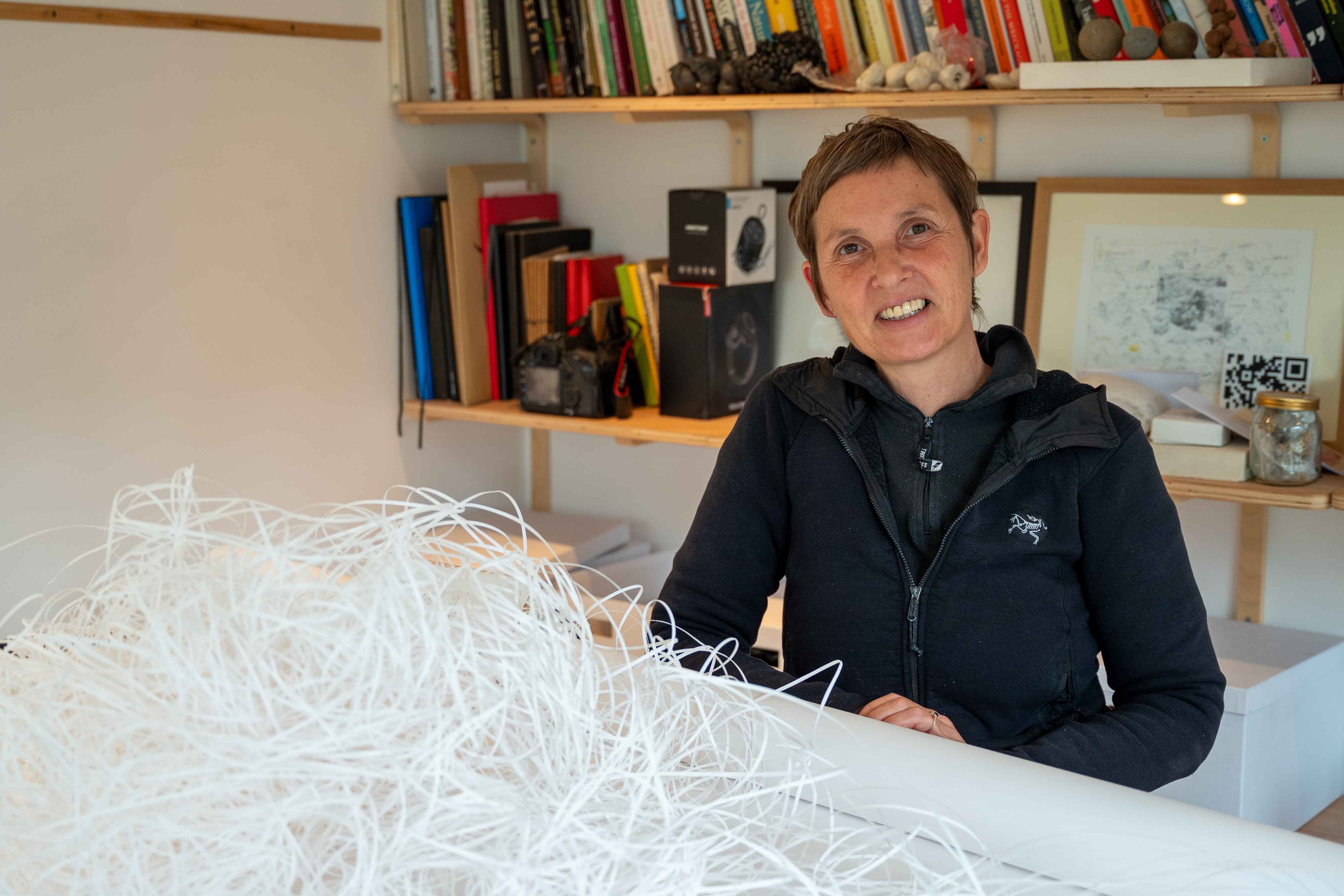Using art to inform the environmental debate
In August 2023, visual artist Miranda Whall lay for 24 hours in a ditch she had dug herself, amidst a newly-installed network of soil sensors high in the uplands of the Cambrian Mountains.
She wore a pair of headphones through which she listened to and recited a continuous stream of live data emitted by the sensors as they monitored the temperature and moisture of the soil around her.
The event was streamed live on social media as part of an ecological, posthumanist performance by Whall titled When Earth Speaks: Soil Voices 2023.
On the morning of the performance, Whall was interviewed on BBC Radio Wales and by the afternoon, with the help of BBC News posts, the live stream had drawn an audience of thousands of viewers from across the globe.
The following year, in June 2024, Whall staged another live performance titled When Earth Speaks: A Dirty Ensemble 2024. Commissioned by the Live Art Development Agency (LADA), the performance at Theatr y Werin in Aberystwyth Arts Centre drew together an invited ensemble of international improv experimental musicians and a Butoh dancer to respond to the soil sensor data stream as it was broadcast live into the theatre.
“This was a multi-layered, multi-perspective piece,” explains Whall, a lecturer at Aberystwyth University’s School of Art.
“Through the sensor network, scientists at the University’s Pwllpeiran Upland Research Centre are able to extract and analyse information about the fluctuating condition of the soil accross a variable landscape over time.
“Through my artistic intervention I have given the soil a voice - honouring it, spending time with it and highlighting the environmental significance of the uplands in today’s climate crisis as a vital carbon sink.
“As important as the environmental questions raised by the work are to me, it was equally important to offer the theatre audience at the Arts Centre the opportunity to experience a unique, improvised, and experimental performance by six highly accomplished musicians and a professional dancer. I hope the audience came away with a sense of being with the Earth, and reflected on how we, as humans, connect with soil and the natural world around us.”
When Earth Speaks 2022- 2024 was the first in a series of research-as-practice projects where Whall uses the environment to create artwork and live performance pieces, and uses art to inform the wider debate around climate change and sustainability.
Making the Invisible Visible
The idea of taking the scientific data generated by the soil sensors to inspire art practice was first developed by Whall in response to a NERC-funded cross-disciplinary research initiative titled Making the Invisible Visible: Instrumenting and Interpreting an Upland Landscape for Climate Change Resilience, led by Professor Mariecia Fraser from the Pwllpeiran Uplands Research Centre.
The project continued to develop in response to a second NERC–funded cross-disciplinary research initiative titled Multi-species politics in Action, led by Professor Milja Kurki from the Department of International Politics at Aberystywth.
“Over the last few years I've been exploring unprocessed quantitative data from scientific research and using that raw data as a material to create drawings, collaborative performances and sculpture,” says Whall.
“Science generates vast volumes of ‘raw’ data and some of it gets processed and analysed and some of it doesn't. So, in a way, it's a kind of untapped material. It feels like an invisible material and it excites me to draw it out and manifest it through my art, making it accessible to a wider audience.
“The critical dimension at play in this series of work is in response to the generation and storage of environmental data, with the work in part highlighting the implications and impact of both.”
Whall’s second project in her series of sci-art projects is titled When Seeds Speak 2023-2024, which was supported by Aberystwyth University's Institute of Biological, Environmental and Rural Sciences (IBERS), Rural Futures Wales Hub, and AberInnovation, and which was made through consultation with Dr Catherine Howarth.
This time, Whall invited musicians, a Butoh dancer and a composer to respond and interact with a raw unprocessed dataset generated by the metabolomic fingerprint analysis of a Black Oat seed (Ceirch Du Bach). An emergent, experimental and improvised performance was staged at the Seligman Theatre, Chapter Arts Centre, Cardiff in September 2024.
When Peat Speaks
Whall is currently developing content for a series of drawings, sculptures and live outdoor performances to be staged over 2025 and 2026 under the umbrella title When Peat Speaks.
“This year-long project is just beginning, with the first performance — When Peat Speaks: A Boggy Cloudy Performance — planned for June-July 2025, supported by the University’s Rural Futures Wales and The Worlds We Want pump prime grants.
“For this 24-hour live-streamed performance, I will be inside an inflatable bubble tent staged on the degraded ‘Cinderella’ peat bog, adjacent to the Greenhouse Gas Removal (GGR) peatland research site at Pwllpeiran.
“I will be listening to a continuous stream of data emitted from a specially installed peat sensor. In response, I will create a large drawing-sculpture made from a 10-metre roll of paper. I will mark each data point with a pin-prick to create thin lines of pricked paper which will be cut into narrow strips to form an accumulative large, amorphous, formless white cloud - a kind of data cloud.”
Whall is also planning to stage a second multi-media performance titled When Peat Speaks: A Boggy Ensemble on a healthy 7,000-year-old water-logged peat bog high in the Cambrian Mountains. This performance, staged for a live audience at dusk in May 2026, will involve an international ensemble of musicians and dancers.
When Peat Speaks is being supported through CO2RE, the UK’s national research hub on Greenhouse Gas Removal which is funded by UK Research and Innovation (UKRI).

Crossed Paths
In an earlier project titled Crossed Paths – Sheep, funded by Arts Council Wales, Whall crawled five and half miles across the rugged, remote landscape of the Cambrian Mountains. She wore a sheep fleece on her back and had 14 Go-Pro cameras attached to her body, recording her every hand and knee-step.
Whall used the footage to create an eight-screen audio and video installation, which formed part of her solo exhibition at the Oriel Davies Gallery, Newtown, Powys, in spring 2018.
She used a similar format to develop two other projects: Crossed Paths – Badger in 2019, where she crawled with the stuffed head of a badger on her back on the hour every hour in an ancient woodland for 24 hours. This was followed by Crossed Paths – Trees which saw Whall crawling with a potted tree on her back across various terrains in a range of locations, including a Scots Pine for the COP 26 climate change conference in Glasgow in 2021 and an olive tree for COP27 Sharm el-Sheikh, Egypt, in 2022.
“As an artist, I am trying to speak from a different perspective to scientists. In the current climate crisis, we've got to bring all voices to the table - statisticians, data analysts, environmental scientists, geographers, politicians etc. What artists bring is imagination and aesthetics. We have an ability to think around things in a non-linear way and that opens up a new way of thinking. We need to shift paradigms and we need to change behaviour. Artists can contribute to those shifts and take the debate to different audiences.”
Whall’s work was featured in Soil: The World At Our Feet, a landmark exhibition held at Somerset House, London, between January and April 2025, examining the role soil plays in all our lives. It was co-curated by the Land Gardeners, Henrietta Courtauld and Bridget Elworthy; curator and writer May Rosenthal, and Claire Catterall, Senior Curator at Somerset House Trust.
Further Information

Get in touch
As a University, we’re always keen to share our knowledge and expertise more widely for the benefit of society. If you’d like to find out more or explore how you can collaborate with our researchers, get in touch with our dedicated team of staff in the Department of Research, Business and Innovation. We’d love to hear from you. Just drop an e-mail to:
